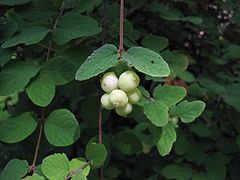Symphoricarpos mollis
| Symphoricarpos mollis subsp. var. | ||||||||||||||||||||||||||||||||||||||||||||||||||||||||
|---|---|---|---|---|---|---|---|---|---|---|---|---|---|---|---|---|---|---|---|---|---|---|---|---|---|---|---|---|---|---|---|---|---|---|---|---|---|---|---|---|---|---|---|---|---|---|---|---|---|---|---|---|---|---|---|---|

|
|
| ||||||||||||||||||||||||||||||||||||||||||||||||||||||
| ||||||||||||||||||||||||||||||||||||||||||||||||||||||||
Symphoricarpos mollis is a species of flowering plant in the honeysuckle family known by the common names creeping snowberry, Southern California snowberry, and trip vine. It is found across western North America.
The plant is a tall creeping shrub which bears bunches of red or pink rounded, bell-shaped flowers and spherical or bulbous white or pink-tinted fruits. The fruits are not generally considered toxic but are distasteful, having a soapy texture due to the presence of saponins.
The shrub does well in warm climates and can tolerate both intense sun and constant shade. It is a plant of chaparral ecosystems, especially along coastlines. It reproduces via rhizome and seed.
Cultivation
Propagation
Pests and diseases
Varieties
Gallery
-
photo 1
-
photo 2
-
photo 3
References
External links
- w:Symphoricarpos mollis. Some of the material on this page may be from Wikipedia, under the Creative Commons license.
- Symphoricarpos mollis QR Code (Size 50, 100, 200, 500)
